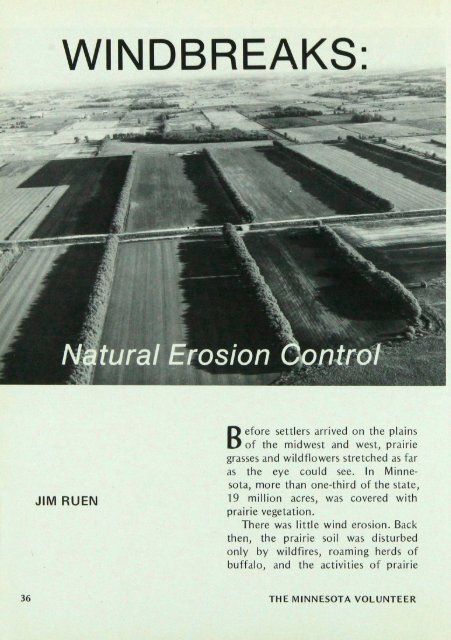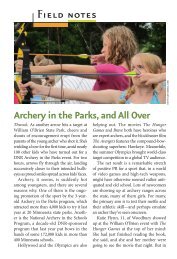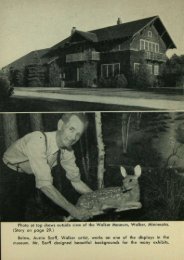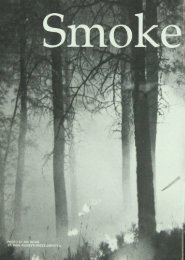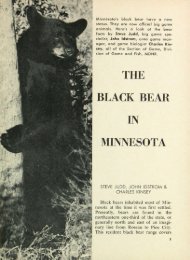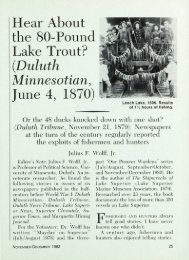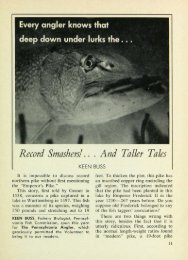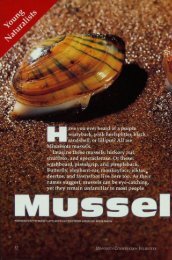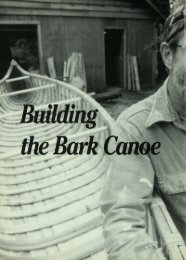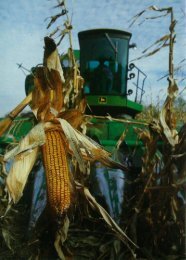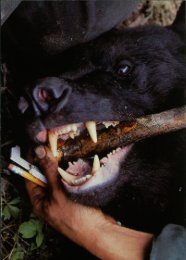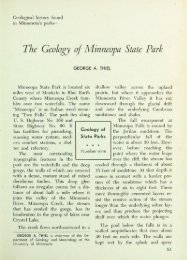1945 Windbreaks: Natural Erosion Control - webapps8
1945 Windbreaks: Natural Erosion Control - webapps8
1945 Windbreaks: Natural Erosion Control - webapps8
Create successful ePaper yourself
Turn your PDF publications into a flip-book with our unique Google optimized e-Paper software.
WINDBREAKS<br />
Before settlers arrived on the plains<br />
of the midwest and west, prairie<br />
grasses and wildflowers stretched as far<br />
as the eye could see. In Minnesota,<br />
more than one-third of the state,<br />
JIM RUEN million acres, was covered with<br />
prairie vegetation.<br />
There was little wind erosion. Back<br />
then, the prairie soil was disturbed<br />
only by wildfires, roaming herds of<br />
buffalo,<br />
and the activities of prairie<br />
36 THE MINNESOTA VOLUNTEER
dogs and other wildlife. But then came<br />
the western movement and the moldboard<br />
plow. Before long, vast expanses<br />
of prairie were replaced by corn and<br />
wheat. Cattle and sheep often overgrazed<br />
vegetation that was not plowed<br />
under.<br />
The importance of trees on the<br />
open prairie was recognized as early as<br />
1873 with passage of the Timber<br />
Culture Act. This bill offered homesteaders<br />
160 acres if they would plant<br />
trees on 40 acres. The Act was repealed<br />
less than two decades later, but<br />
not before millions of trees had been<br />
planted.<br />
Meanwhile, taming of the wild<br />
prairie continued. More land was converted<br />
to crops so that, by the end of<br />
the century, the frontier was virtually<br />
closed.<br />
Dirty Thirties. It didn't take long<br />
before Americans began to pay the<br />
price for destroying the prairie grasses<br />
and flowers which had held the dry,<br />
sandy soil in place. And the price was<br />
high—the infamous dust bowl of the<br />
1930s. Drought came to the prairies.<br />
Older farmers still tell of dust clouds<br />
hundreds of feet high, burying<br />
machinery and fence lines in drifts of<br />
soil. With farm prices at rock bottom<br />
because of the depression, the drought<br />
forced many farmers off the land.<br />
The federal government declared<br />
war on the devastating erosion by<br />
establishing the Prairie States Forestry<br />
Project in 1935. The project provided<br />
money for the Work Progress Administration<br />
(WPA) and the Civilian Conservation<br />
Corps (CCC) to plant trees for<br />
erosion control. From 1935 to 1942,<br />
more than 200 million trees and<br />
shrubs were planted from Texas to<br />
Minnesota and from the Rocky Mountains<br />
to the eastern border of<br />
Nebraska. More than 238,000 acres<br />
were planted to windbreaks.<br />
These shelterbelts proved invaluable.<br />
They broke the force of the<br />
ever-present prairie wind, protecting<br />
soil particles along with newly-planted<br />
seed and young plants. The windbreaks<br />
reduced evaporation from the<br />
soil and trapped snow during winter,<br />
saving moisture for the coming growing<br />
season. They beautified the landscape<br />
and improved living conditions<br />
for humans, livestock, and wildlife.<br />
But once again man is changing the<br />
pattern of the prairie. With renewed<br />
emphasis on expanded farm production,<br />
higher land values and resulting<br />
higher taxes, farmers are striving to get<br />
the most from their acres. The recent<br />
drought, for example, catalyzed a<br />
boom in farmland irrigation on sandy<br />
soils.<br />
Today, many people fear that, as<br />
irrigation grows, the windbreak will go<br />
the way of the big bluestem and the<br />
prairie conefiower. Many shelterbelts<br />
are in the way of the sweep of center<br />
pivot irrigation systems, and thus are<br />
being wholly or partially removed.<br />
Windbreak removal is not a serious<br />
problem in Minnesota, but it is occurring<br />
in the southern plains states<br />
where snow retention is not a factor<br />
)ANUA RY —FEBRUARY 1978 37
System developed in Nebraska (left) shows section of center pivots<br />
and windbreaks. Trees are primarily red cedars six feet apart in two to<br />
four rows. Right: Low-growing shrubs across diameter of quartersection<br />
center pivot circle is being tried in North Dakota. Fifty-foot<br />
Cottonwood, or northwest poplars, border outer edge of North<br />
Dakota system. (Artwork courtesy of Irrigation Age magazine.)<br />
and in areas where center pivot irrigation<br />
is being installed.<br />
To aid farmers in soil erosion control<br />
under center pivot irrigation systems,<br />
the SCS advises use of annual<br />
row crops such as corn or the planting<br />
of shrubs at intervals throughout the<br />
field.<br />
Few farmers are using shrubs because<br />
of the expense and labor needed<br />
to keep the plantings trimmed to a<br />
height below the center pivot boom. If<br />
a mechanical hedge row trimmer could<br />
be developed, interest in shrubs would<br />
increase greatly.<br />
Irrigation is a relatively recent development<br />
in Minnesota agriculture,<br />
one which is growing rapidly. As of<br />
last June, 387,000 acres were sprinkler<br />
irrigated. It is estimated that at least<br />
two-thirds of this acreage is under<br />
center pivot systems.<br />
"Five years ago, shelterbelts were<br />
being torn out to accommodate center<br />
pivots, but with no provision to replace<br />
the trees," said Fred Bergsrud,<br />
Irrigation Specialist at the University<br />
of Minnesota. "Today farmers have<br />
become more aware of the potential<br />
problems. Ottertail County was the<br />
first to notice a problem with wind<br />
erosion. There and in similar areas in<br />
Minnesota the SCS and the University<br />
are working with farmers to find a<br />
solution."<br />
New Ordinance. Sherburne and<br />
Benton counties, two rapidly ex-<br />
38 THE MINNESOTA VOLUNTEER
panding irrigation areas, have suffered<br />
soil losses because of windbreak removal.<br />
Benton County commissioners<br />
have passed an ordinance controlling<br />
removal of windbreaks, one of the few<br />
such laws in the nation. It requires<br />
farmers to develop alternative plans<br />
for soil conservation before they can<br />
remove a field windbreak. Kevin Adelman,<br />
SCS technician for the two<br />
counties, said the ordinance has cut<br />
windbreak removal in half.<br />
About 30 miles of windbreaks have<br />
been removed in Benton and Sherburne<br />
counties, mainly because of new<br />
irrigation projects. But only two miles<br />
have been replaced. William Held of<br />
Rice has started to replace some of the<br />
six miles of shelterbelt he removed,<br />
planting trees on the perimeter of his<br />
fields. (<strong>Windbreaks</strong> on the outside of a<br />
field do not offer the protection of<br />
single-row windbreaks every 600 feet.<br />
However, SCS endorses their use in<br />
combination with other soil conservation<br />
methods.)<br />
"Most farmers in the two counties<br />
have begun a program of minimum<br />
tillage or mulch tillage in an effort to<br />
protect the soil," said Adelman. One<br />
landowner, Joe Gottward of Rice,<br />
moved part of his windbreak out of<br />
the way of his center pivot system and<br />
replanted the trees elsewhere. Other<br />
farmers have attempted to replant, but<br />
dry weather in 1975 and 1976 killed<br />
the young trees. Farmers indicate that,<br />
if they receive enough snow this winter,<br />
they will try again next spring.<br />
Many soil experts believe that windbreaks<br />
not only will prevent wind<br />
erosion on an irrigated field, but will<br />
make the unit more efficient. Water<br />
can be distributed better with less<br />
evaporation if a windbreak adjoins the<br />
pivot system.<br />
Irrigation isn't the only cause of<br />
windbreak removal. In the Red River<br />
Valley, windbreaks of Siberian elm<br />
planted about 15 years ago are now<br />
dying. "The fungus has been isolated,<br />
but it is a secondary cause of death,"<br />
said Scottie Scholten, University of<br />
Minnesota College of Forestry professor.<br />
"The trees have been weakened<br />
by annual crop spraying."<br />
John Hultgren, SCS Woodland Conservationist<br />
in Minnesota, agrees that<br />
crop spray may damage windbreaks of<br />
Siberian elm. "Monoculture is always a<br />
problem," he said. "Siberian elm<br />
looked like the perfect tree, so that<br />
was all that was planted. Today we<br />
encourage a variety of trees in a<br />
shelterbelt, such as a mixture of Siberian<br />
elm, green ash, and cottonwood.<br />
This decreases the likelihood of<br />
disease and insect infestation as well as<br />
the chance of crop spray wiping out<br />
the entire shelterbelt."<br />
The SCS, U.S. Forest Service Extension<br />
Service, and the University of<br />
Minnesota Experiment Stations are<br />
constantly searching for new seedstock<br />
and alternative species to use in field<br />
windbreaks. "We are now looking at a<br />
seed source which will give us a ponderosa<br />
pine with more upright<br />
branches for better snow distribution<br />
across the field," said Scholten. "This<br />
)ANUA RY —FEBRUARY 1978 39
is an important tree in western Minnesota<br />
because of its ability to grow well<br />
in prairie soils."<br />
Another problem faced by owners<br />
of field windbreaks is the replacement<br />
of dying or damaged trees. Old trees<br />
which no longer provide adequate soil<br />
protection may cause the farmer to see<br />
complete removal of the windbreak as<br />
his only option. But there are others.<br />
Replacing all or part of the tree line<br />
can be done over a period of time by:<br />
1) interspersing old trees with young;<br />
2) beginning a second row of young<br />
trees behind a mature row; 3) cutting<br />
down the original growth so it will<br />
grow back from the stumps. "Many<br />
hardwood (deciduous) trees and<br />
shrubs will send out sprouts from the<br />
stump," advises Hultgren. "Simply<br />
choose the straightest or healthiest<br />
looking stem and trim away the rest.<br />
Such regrowth can quickly replace the<br />
trees cut down."<br />
Inventory. The Soil Conservation<br />
Service (SCS) is currently inventorying<br />
shelterbelts in the nation's five major<br />
windbreak states: Kansas, Nebraska,<br />
Oklahoma, and North and South<br />
Dakota. The nine-month study is in<br />
response to a 1975 General<br />
Accounting Office (GAO) report calling<br />
for action to discourage removal of<br />
windbreaks in the Great Plains. Using<br />
aerial photographs, the study is accumulating<br />
up-to-date information on<br />
the number of field windbreaks in the<br />
region, number removed during recent<br />
years, and reasons for their removal.<br />
William Lloyd, Chief Forester for<br />
the SCS (Washington, D.C.), believes<br />
that too much emphasis has been<br />
placed on just the erosion control<br />
benefit of windbreaks. "With the introduction<br />
of minimum tillage, annual<br />
grasses, stripcropping, and other forms<br />
of intensive soil management, windbreaks<br />
are no longer a necessity for<br />
short term erosion control," he said.<br />
"Instead, the biggest losers when shelterbelts<br />
are removed are wildlife habitat<br />
and recreational opportunities.<br />
"The problem is," he continued,<br />
"there is no economic incentive to<br />
cause the farmer to use the land for<br />
shelterbelts when he could use it for<br />
cash crops."<br />
Fortunately, Minnesota is one of<br />
the leading states in planting trees for<br />
field and farmstead windbreaks. In<br />
1976, landowners planted nearly onehalf<br />
million trees for field windbreaks,<br />
offering more than 288 miles of protection.<br />
This increased to 396 miles of<br />
windbreaks planted in 1977, despite<br />
advances in irrigation. This is encouraging<br />
proof that windbreaks are<br />
not a thing of the past, at least in<br />
Minnesota. Interest in the many benefits<br />
of windbreaks remains high and<br />
their continued existence appears certain.<br />
•<br />
Jim Ruen is an Editorial Assistant for<br />
the USDA Soil Conservation Service<br />
in St. Paul.<br />
40 THE MINNESOTA VOLUNTEER


